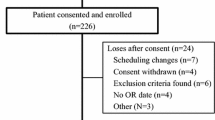Summary
A number of studies in medical literature suggest that during implantation of hip prostheses pulmonary embolism of medullary contents and of air may occur. Proof of this suggestion was based on histological examination of lung tissue in animal experiments as well as on post mortem examinations of human tissue. In vivo evidence of this suspected embolism has been lacking so far, since an appropriate technique has not been available. Using transesophageal two-dimensional echocardiography, continuous imaging of the right atrium and the right ventricle can be performed in order to prove this suspected embolization in vivo. Thus, in a prospective randomized study of 26 patients undergoing hip surgery, the right atrium and right ventricle were continuously imaged. Simultaneously, the end-expiratory CO2 partial pressure was recorded. The medical literature suggests that a venting hole in the shaft of the femur prevents the rise in pressure in the medullary space and thus also averts embolism. Therefore, prior to the implantation of the shaft prosthesis, and in order to vent the medullary space, in 13 patients a 4.5-mm lateral borehole was drilled into the femoral shaft, located two finger breadths distal to the point were the end of the prosthesis would be positioned. In 12 of 13 patients in the control group without boreholes, transesophageal two-dimensional echocardiography revealed that air bubbles formed during the implantation of the shaft. In the group with boreholes, however, presence of air could be demonstrated in only four patients (P < 0.01). Emboli were detectable in eight patients in the control of group, but in only two patients in the group with boreholes (P < 0.05). In the control group the median end-expiratory CO2 partial pressure dropped from 35 to 33 mmHG (P < 0.01) because of embolism, but in the group with venting holes this value was 35 mm Hg before as well as after implantation. Transesophageal two-dimensional echocardiography proves that embolization of air and medullary space contents occurs during the implantation of hip prostheses. A venting hole in the shaft of the femur may help to reduce the incidence of intraoperative embolization of air and medullary space contents occuring during shaft implantation, but it cannot eliminate this completely.
Similar content being viewed by others
References
Breed AL (1974) Experimental production of vascular hypotension, and bone marrow and fat embolism with methylmethacrylate cement. Clin Orthop 102:229
Beaupre PN, Kremer PIT, Cahalan MK, Lurz FW, Schiller NB, Hamilton WK (1984) Intraoperative detection of changes in left ventricular segmental wall motion by transoesophageal two-dimensional echocardiography. Am Heart J 5:1021
Cadle D, James ML, Ling RSM, Piper RF, Pryer DL, Wilmhurst CC (1972) Cardiovascular responses after methylmethacrylate cement. Br Med J 14:107
Cahalan MK, Kremer PF, Beaupre PN, Lurz FW, Roizen MF, Cronnely R, Robinson S, Hamilton WK, Eger El, Schiller NB (1984) Consistency and reproducibility of transoesophageal two-dimensional echocardiography. Anesth Analg 63:175
Eggert A, Huland H, Ruhnke J, Seidel H (1974) Der Übertritt von Methylmethacrylat-Monomer in die Blutbahn des Menschen nach Hüftgelenksersatzoperationen. Chirurg 45:236
Heinrich H, Kremer P, Winter H, Wörsdörfer O, Ahnefeld FW (1985) Transoesophageale zweidimensionale Echocardiographie bei Hüftendoprothesen. Anaesthesist 34:118
Kallos R, Enis JE, Gollan F, Davis JH (1974) Intramedullary pressure and pulmonary embolism of femoral medullary contents in dogs during insertion of bone cement and a prosthesis. J Bone Joint Surg 56:1365
Kim KC, Ritter MA (1972) Hypotension associated with methacrylate in total hip arthroplasties. Clin Orthop 88:154
Koch H, Dustmann HO, Schultz KP (1972) Die Prophylaxe der Fettembolie beim Hüftgelenksersatz durch Cholinphospholipide und Druckentlastung. Arch Orthop Trauma Surg 72:272
Kremer P, Schwartz L, Cahalan MK, Gutman J, Schiller NB (1982) Intraoperative monitoring of left ventricular performance by transoesophageal M-mode and 2-d echocardiography. (abstract) Am J Cardiol 49:956
Modig J, Busch C, Olerud S, Saldeen T, Waernbaum G (1975) Arterial hypotension and hypoxaemia during total hip replacement: the importance of thromboplastic products, fat embolism and acrylic monomers. Acta Anaesthesiol Scand 19:28
Nice EJM (1973) Case report: cardiac arrest following use of acrylic bone cement. Anaesth Intensive Care 13:244
Powell JN, McGrath PJ, Lahiri SK, Hill P (1970) Cardiac arrest associated with bone cement. Br Med J 3:326
Rinecker H (1980) New clinico-pathophysiological studies on the bone cement implantation syndrome. Arch Orthop Trauma Surg 97:263
Rudiger J, Grünert A (1978) Tierexperimentelle Untersuchungen zur Pathogenese intraoperativer Kreislauf- und Atmungsreaktionen bei Implantation sogenannter Knochenzemente in die Markhbhle eines Röhrenknochens. Arch Orthop Tauma Surg 91:85
Schlag G, Schliep HJ, Dingeldein E, Grieben A, Ringsdorf W (1976) Sind intraoperative Kreislaufkomplikationen bei Alloarthroplastiken des Hüftgelenks durch Methylmethacrylat bedingt? Anaesthesist 25:60
Schlüter M, Thier W, Hinrichs A, Kremer P, Siglow V, Hanrath P (1984) Klinischer Einsatz der transösophagealen Echokardiographie. Dtsch Med Wochenschr 109:722
Schuh FT, Moelling Schuh S, Viguera MG, Terry RN (1973) Circulatory changes following implantation of methylmethacrylate bone cement. Anesthesiology 39:455
Tronzo RG, Kallos T, Wyche MQ (1974) Elevation of intramedullary pressure when methylmethacrylate is inserted in total hip arthroplasty. J Bone Joint Surg 56:714
Zichner L (1972) Embolien aus dem Knochenmarkkanal als Ursache von Sofort- und Spätkomplikationen nach Einsetzen von intramedularen Femurkopfendoprothesen mit Polymethylmethacrylat. Helv Chir Acta 39:717
Author information
Authors and Affiliations
Rights and permissions
About this article
Cite this article
Ulrich, C., Burri, C., Wörsdörfert, O. et al. Intraoperative transesophageal two-dimensional echocardiography in total hip replacement. Arch. Orth. Traum. Surg. 105, 274–278 (1986). https://doi.org/10.1007/BF00449925
Received:
Issue Date:
DOI: https://doi.org/10.1007/BF00449925




